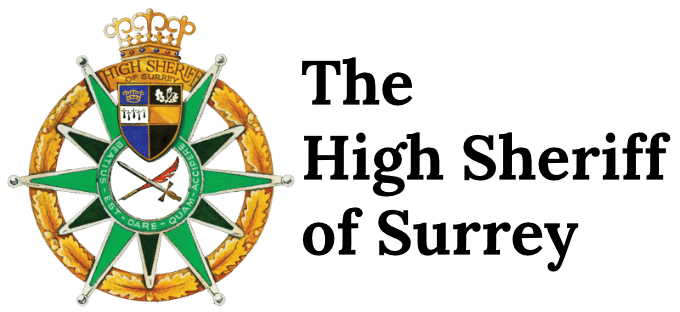The Sheriff is the oldest lay officer in England and is an appointment made directly by the Monarch.
The precise date of its origin is lost in the mist of time but the first named High Sheriff of Surrey, Ansculf de Picqiugny, is listed as being in post during the reign of William I 1066-1087.
In the post Conquest period, the power of Sheriffs was at its height combining the roles of Royal official, tax collector, judge and military leader. They had powers of arrest and to raise the “hue and cry” to pursue villains. The Shrievalty is closely linked to events in history. The names of Surrey Sheriffs appear in the Domesday Book, on Magna Carta and at the bottom of the Death Warrant of Charles I. Catholic Sheriffs of Surrey burned twenty seven Protestant martyrs under Mary I and during the Interregnum in the 1650s puritan Sheriffs pulled down theatres and shot performing bears.
Magna Carta has especial relevance to Surrey as the then High Sheriff, Hubert de Burgh, was King John’s Chief law officer and was at his side when King John placed his seal on Magna Carta. Of the 63 clauses of the Magna Carta, 27 had some bearing on the office of Sheriff including the 45th which stated that no man ignorant of the law should be appointed to the office of Sheriff. History does not reveal when this intent has been ignored! Today a “High Sheriff” is the Sheriff of a county as opposed to a plain “Sheriff” of a town or borough.
The splendid booklet “The High Sheriffs of Surrey” by David Burns published in 1992 relates in some detail the changing role and functions of High Sheriffs over the millennium and in particular names all the High Sheriffs since Ansculf de Picquig and provides a fascinating account of the strengths and failings of High Sheriffs over the years.
The current High Sheriff calculates he is the 796th named Sheriff of Surrey. In the early centuries High Sheriffs were frequently in office for more than one year. From 1242 to 1635 Surrey and Sussex had the same High Sheriff, and until the 20th century Surrey was a much larger County than it is today including much of London south of the Thames. As Southwark was a major centre for brewing from the 17th century the Surrey shrievalty became closely associated with the brewing industry with leading brewers holding the office.
Until 1235 it was very profitable role to be High Sheriff as the incumbent paid a fixed annual sum to the Monarch and retained any surplus from the rents and taxes he collected, a process known as “farming” the shire. In the sixteenth century the duties of the High Sheriff were reduced and the office continued its financial decline, such that men would go to great lengths to avoid being appointed. The burden was increased by the large retinue a Sheriff was in those days obliged to employ, including a personal chaplain, the under Sheriff and his deputies, pages, bailiffs, javelinmen, trumpeters and footmen. A 21st Century High Sheriff does not have such an entourage.
The 15th Century was not a good century for High Sheriffs. In 1450, James Fiennes (later Lord Say) High Sheriff in 1438 was hanged drawn and quartered and if that wasn’t enough beheaded by Jack Cade’s rebels in 1450. John Lewknor High Sheriff in 1450 was slain on 4th May 1471 at the Battle of Tewkesbury. Captured at that battle and beheaded two days later was Thomas Tresham, High Sheriff in 1458 who had also been Speaker of the House of Commons, and if that wasn’t enough, Thomas St. Leger, High Sheriff in 1471 was beheaded in Exeter on November 12th 1483.
In more recent times the role of High Sheriff has not involved such risks and there have been many distinguished holders of the office in Surrey from many areas of life. One brewing family, the Barclays, filled the Sheriffdom for three consecutive generations in 1842, 1878 and 1923. Albert Sandeman became High Sheriff in 1872 when only 39 years old and went on to be Governor of the Bank of England. John Strachey (1914) was for many years editor and proprietor of the Spectator. More recently Sir Hugh Dundas (1989) was a distinguished Battle of Britain pilot.
The First Lady High Sheriff of Surrey was not appointed until 1975 when Mrs Marney Du Boison of Holmbury St Mary took office. Since then there have been seven Lady High Sheriffs.
Whilst the role has changed over the years the focus on supporting the judiciary continues
alongside much activity highlighting and celebrating the work of charities and volunteers across the County of Surrey.
One tradition that continues is the Pricking Ceremony when the Queen chooses her Sheriffs using a silver bodkin to mark the names of the Sheriffs for the ensuing year. On taking office the new High Sheriff has to make a Declaration set out in the Sheriff’s Act of 1887. The Declaration is difficult to read as it contains some of the longest sentences in the English language including the memorable words “I will truly and diligently execute the good Laws and Statutes of the Realm, and in all things well and truly behave myself in my Office for the honour of the Queen and the good of her subjects, and discharge the same according to the best of my skill and power”.
Written By Robert Napier CBE, High Sheriff of Surrey 2017-18
